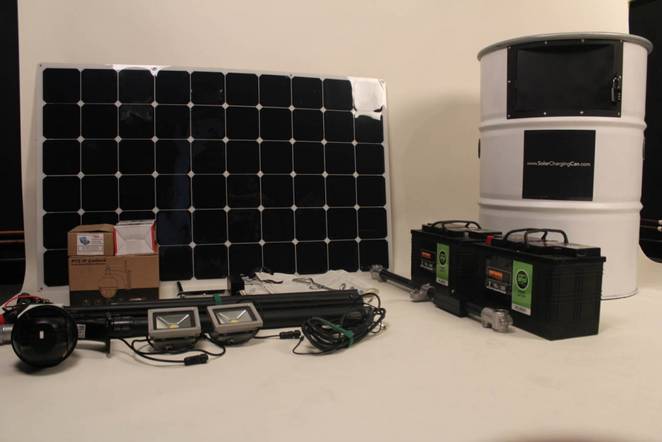Here’s the scenario. You’re at the beach, sitting by the pool, hiking in the wilderness or working in your garden. You’d like to keep your phone or tablet charged but there’s no power source nearby, nothing to plug into for juice. The standard remedy is to go buy an external battery — or battery case — and keep that around for backup power. But backup batteries run dry, too. What then?
The sun. Yes, that big yellow ball in the sky has long been seen as a potential power source for our gadgets. But until recently, solar-powered chargers weren’t reliable. For starters, they were expensive. And more importantly, they took way too long to charge anything.
But that’s changed over the last five years: The latest batch of solar-charging gear is significantly improved and more affordable. I’ve tested products from BioLite, Goal Zero, WakaWaka and others, and while most solar chargers won’t power up your phone as fast as a wall outlet would, design and technology enhancements have cut charging times.
Why are they better?
More-efficient solar cells allow manufacturers to cram more wafers (those thin slices of semiconductor material made of crystalline silicon) into a smaller space, explained Norm Krantz, Goal Zero’s vice president of product innovations. That, in turn, leads to smaller panels that can output more power.
That’s a plus, Krantz said, but what’s really advanced are the electronics coupled to the panel and the tools that help consumers use it.
For example, Goal Zero’s Nomad chargers have an indicator that gives an estimate of the sun’s strength so you can adjust the panel’s angle and placement to maximize performance. Similarly, BioLite has a sundial built into its SolarPanel 5+ and SolarPanel 10+ products that help you maximize the amount of energy you’re collecting. (Several other brands of solar chargers integrate some form of a solar strength gauge.)
“The sundial casts a shadow to help aim the panel perfectly, increasing power output by up to 30 percent,” said Jonathan Cedar, BioLite’s co-founder and CEO. Both BioLite products have an integrated kickstand that doubles as a loop for hanging the panel from a nail or tree branch.
What’s crucial to quicker charge
Don’t get too obsessed with the size of your charger’s solar panel: Bigger isn’t necessarily better. It’s not that panel size doesn’t matter, but having the right solar conditions is more crucial. After all, if the sun isn’t out, even the biggest panel in the world will have trouble charging your device.
Also, phones, tablets, cameras and other small mobile devices have restrictions on how much power they can take in at one time, Goal Zero’s Krantz explained. So, a 100-watt panel won’t charge your phone 10 times faster than a smaller, 10-watt panel. In fact, it won’t charge it any faster at all. What the larger panel can do is charge multiple small devices at the same time.
For most of us, that’s more than we’ll need. But for a smaller gadget, a 5-watt panel will suffice. Typically around the size of a sheet of paper, a 5-watt panel can charge a phone in 3 to 6 hours. Larger 10-watt panels, usually about the size of two sheets of paper when folded out, can power your phone or tablet in about 2 hours in sunny conditions. Just remember that if you’re going with a higher-wattage panel, pick up one that’s relatively compact and not too heavy.
Things get more complicated when charging a laptop or appliance that plugs into a standard wall outlet — you’ll need a larger panel in the 25-watt range and a DC-to-AC inverter. Goal Zero also makes more expensive, heavy-duty solar power “kits” that incorporate large storage batteries designed to run a wide variety of products.
Fortunately, some of that high-end technology has made its way down to portable chargers. BioLite’s Cedar said that large solar arrays have always used features like “maximum power point tracking” to maximize power output under a range of sunlight and temperature conditions. That technology used to be expensive, he explained, but now smaller, portable solar chargers that incorporate a form of it can deliver a 20 percent performance boost.
Stored power is better power
The other big change to solar charging is the addition of integrated batteries, or “onboard storage.” Instead of tethering your phone to the panel and leaving it in the sun to charge, you can power the panel’s integrated battery first and then transfer the charge to your phone later.
“Thanks to the power storage battery, when you get to camp in the evening, you can quickly transfer the stored energy to your devices at wall-plug speeds,” Cedar said.
You’ll find a lot of generic panels for sale online that can charge separate external batteries. Though rechargeable batteries do degrade over time, and you can’t replace them if they’re integrated into a panel’s design, personally I prefer chargers with built-in batteries for the convenience.
Source:
www.cnet.com/news/sunny-days-for-solar-charging

